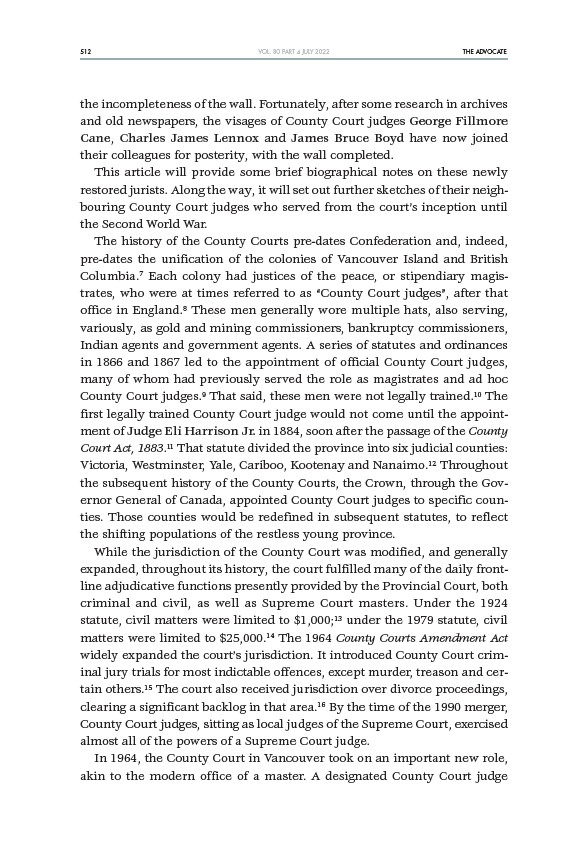
512 THE ADVOCATE
VOL. 80 PART 4 JULY 2022
the incompleteness of the wall. Fortunately, after some research in archives
and old newspapers, the visages of County Court judges George Fillmore
Cane, Charles James Lennox and James Bruce Boyd have now joined
their colleagues for posterity, with the wall completed.
This article will provide some brief biographical notes on these newly
restored jurists. Along the way, it will set out further sketches of their neighbouring
County Court judges who served from the court’s inception until
the Second World War.
The history of the County Courts pre-dates Confederation and, indeed,
pre-dates the unification of the colonies of Vancouver Island and British
Columbia.7 Each colony had justices of the peace, or stipendiary magistrates,
who were at times referred to as “County Court judges”, after that
office in England.8 These men generally wore multiple hats, also serving,
variously, as gold and mining commissioners, bankruptcy commissioners,
Indian agents and government agents. A series of statutes and ordinances
in 1866 and 1867 led to the appointment of official County Court judges,
many of whom had previously served the role as magistrates and ad hoc
County Court judges.9 That said, these men were not legally trained.10 The
first legally trained County Court judge would not come until the appointment
of Judge Eli Harrison Jr. in 1884, soon after the passage of the County
Court Act, 1883.11 That statute divided the province into six judicial counties:
Victoria, Westminster, Yale, Cariboo, Kootenay and Nanaimo.12 Throughout
the subsequent history of the County Courts, the Crown, through the Governor
General of Canada, appointed County Court judges to specific counties.
Those counties would be redefined in subsequent statutes, to reflect
the shifting populations of the restless young province.
While the jurisdiction of the County Court was modified, and generally
expanded, throughout its history, the court fulfilled many of the daily frontline
adjudicative functions presently provided by the Provincial Court, both
criminal and civil, as well as Supreme Court masters. Under the 1924
statute, civil matters were limited to $1,000;13 under the 1979 statute, civil
matters were limited to $25,000.14 The 1964 County Courts Amendment Act
widely expanded the court’s jurisdiction. It introduced County Court criminal
jury trials for most indictable offences, except murder, treason and certain
others.15 The court also received jurisdiction over divorce proceedings,
clearing a significant backlog in that area.16 By the time of the 1990 merger,
County Court judges, sitting as local judges of the Supreme Court, exercised
almost all of the powers of a Supreme Court judge.
In 1964, the County Court in Vancouver took on an important new role,
akin to the modern office of a master. A designated County Court judge